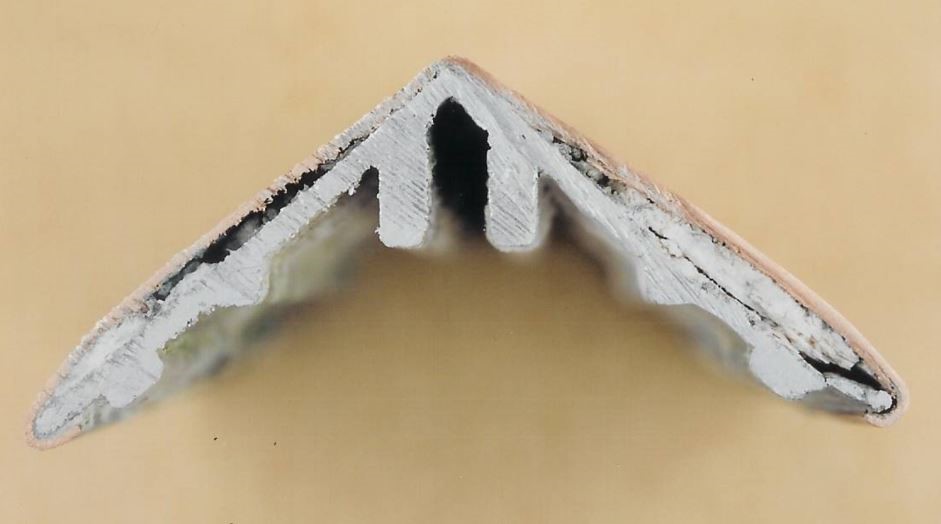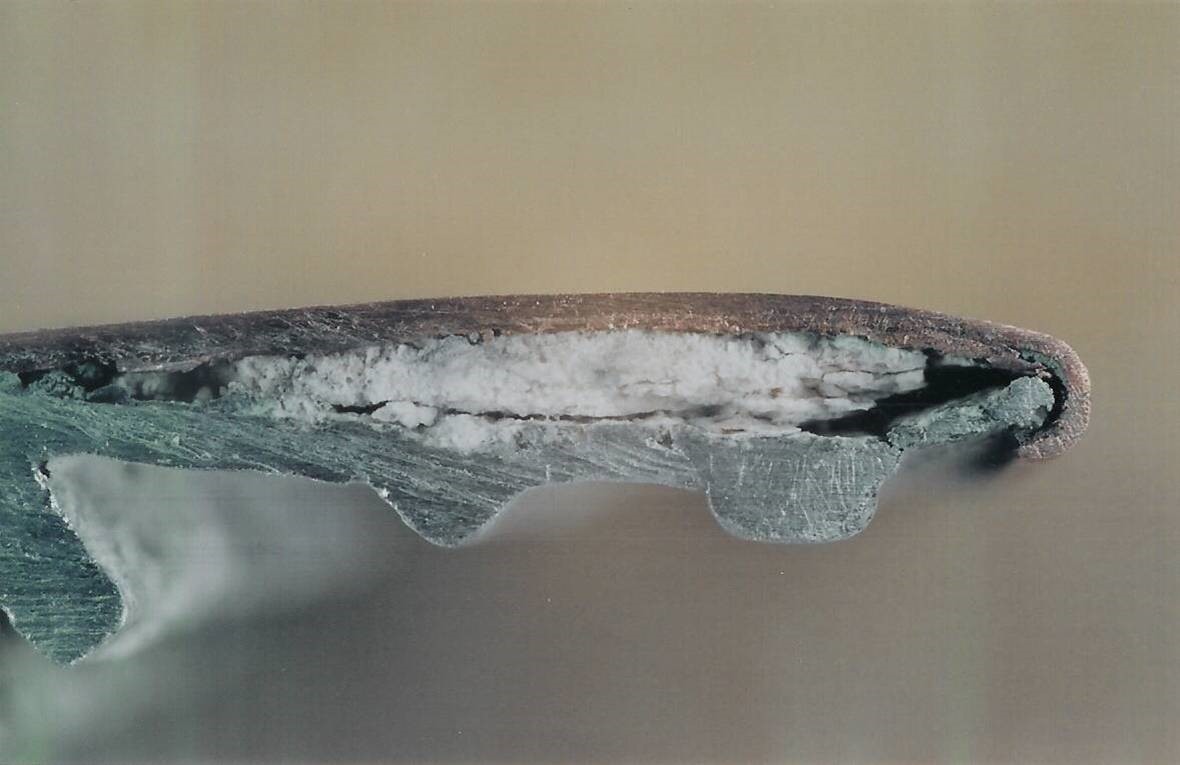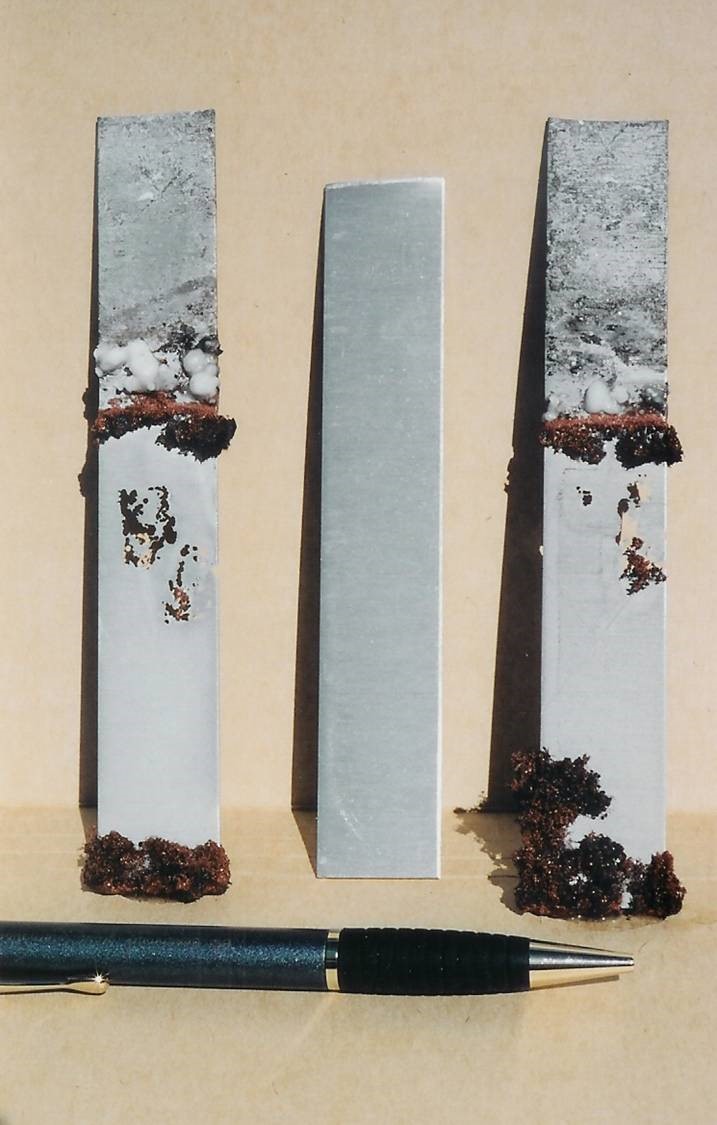Corrosion engineers are familiar with the galvanic series,1 which lists “noble” and “active” metals, and with galvanic corrosion—often referred to as two-metal or dissimilar-metal corrosion. They may well have encountered examples of galvanic corrosion during their field or plant work. This article looks at corrosion damage to aluminum caused by direct metal-to-metal contact with copper and by contact with copper-containing solutions.
Galvanic Corrosion
Several public buildings in Canada have roofs made of copper sheeting. For aesthetic reasons, the use of copper trim was extended down the sides of one multi-story building. The exterior curtain walls of the building consist of large panes of glass held onto a metal framework.
Each pane was secured to the framework by “pressure plates” around its periphery. These plates were aluminum extrusions (approximately 6 cm wide) fitted with elastomer strips that pressed against the glass. Screws were driven through the pressure plates into the window frames to hold each pane in place.
“Dress caps” were fitted over the top of the pressure plates to hide the plates and screws. The dress caps were also aluminum extrusions, in the form of 3.5 x 3.5 cm angle bar. Copper sheet had been mechanically attached to the dress caps by rolling it over their longitudinal edges. Figure 1 shows the elastomer seals, a pressure plate, and a dress cap.
Not surprisingly, direct contact between the copper (noble) and aluminum (active), in the presence of moisture and rainwater, caused significant corrosion damage to the aluminum components (see Figure 1 to 3). The damage eventually caused leaks to develop in the curtain wall and resulted in the complete replacement of the glazing, pressure plates, and dress caps.
To prevent bi-metallic corrosion in the future, while still retaining the copper “look,” angles made of glass fiber-reinforced plastic clad with copper sheet were selected for the replacement dress caps. However, if copper runoff from the dress caps or roof can penetrate to the aluminum pressure plates, then corrosion of these plates may still occur due to deposition corrosion.

Deposition Corrosion
In addition to direct contact between metallic copper and metallic aluminum, corrosion can occur when aluminum is exposed to runoff from copper roofs, flashing, trim, and rain gutters. Although very resilient, copper can suffer a small amount of corrosion when exposed to atmospheric conditions–particularly those encountered in busy cities.
In locations where de-icing salt is used on roads and highways, chloride-containing droplets or aerosols can be deposited on the building. Vehicle exhaust fumes can combine with the chlorides to make exposure conditions more corrosive. If aqueous runoff from the copper comes in contact with aluminum components, metallic copper can be deposited and some of the aluminum will dissolve (corrode).

This process, which is predicted by the galvanic series, is known as deposition corrosion.2 It is illustrated in general form by reactions (1) and (2) involving two dissimilar metals, Ma and Mb:
1. Ma+ + e- → Ma (cathodic reaction: metal deposition)
2. Mb → Mb+ + e- (anodic reaction: metal dissolution)
In the case of aluminum wetted by a copper-containing solution, we have the combined reaction (3):
3. 2 Al (metal) + 3 Cu++ → 2 Al+++ + 3 Cu (metal)↓
This process may be inhibited if the aluminum is protected by an anodized layer that is thick and defect-free.
To illustrate deposition corrosion, pieces of aluminum strip (1.25 mm thick) were partially immersed in a solution of copper sulfate at ambient temperature.

After several weeks of exposure, metallic copper precipitated on the aluminum and extensive thinning and perforations were observed on the aluminum strips. Figure 4 shows two aluminum strips with deposits of copper (red-brown material) along with the corrosion suffered by the aluminum.
Deposition corrosion has found an application in extractive metallurgy. Heaps of crushed ore containing copper are sprayed with acidic solutions that percolate down through the heaps and dissolve the copper (heap leaching). The copper-bearing runoff is directed into gullies that are filled with scrap iron.
Metallic copper is deposited on the iron and a corresponding amount of iron goes into solution. This historically useful process is often referred to as “cementation metallurgy” and is illustrated by reaction (4), where (aq) = aqueous and (s) = solid:
4. Cu2+ (aq) + Fe (s) → Cu (s) + Fe2+ (aq)
Conclusions
Directly combining aluminum and copper on the exterior of a building should be avoided—particularly in locations that have more corrosive environments.
When considering aluminum windows, door frames, and other architectural features for a building with a copper roof, care should be taken to provide effective eaves-troughs and downspouts to collect the runoff from the roof and properly convey it to drains at ground level.
Editor’s note: This article first appeared in the September 2023 print issue of Materials Performance (MP) Magazine. Reprinted with permission.
References
1 M. Fontana, Corrosion Engineering, 3rd ed., (New York, NY: McGraw Hill, 1986): p. 43.
2 “Corrosion of Aluminum and Aluminum Alloys,” Metals Handbook, 9th ed., vol. 13 (Metals Park, OH: ASM International, 1987): p. 589.